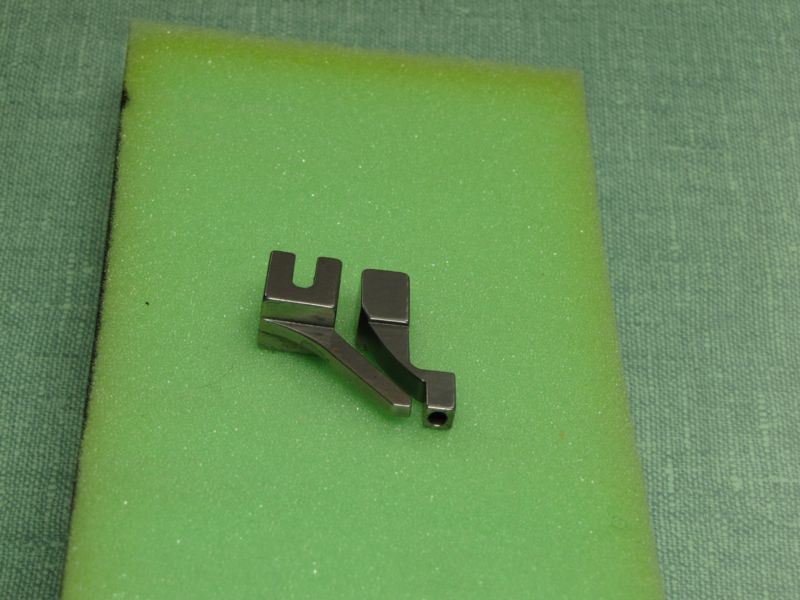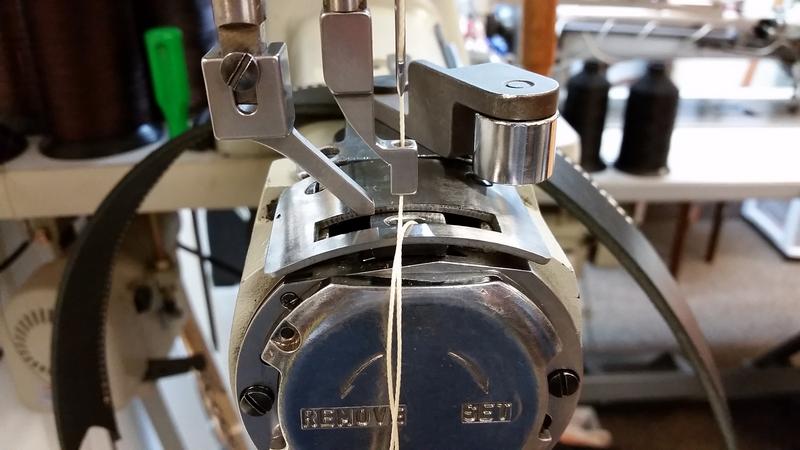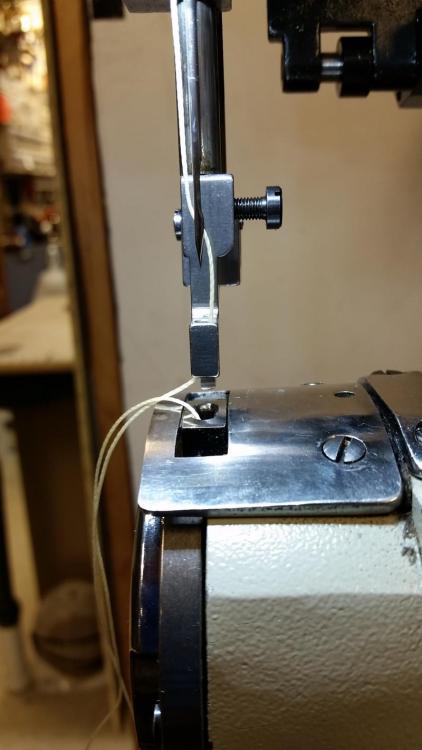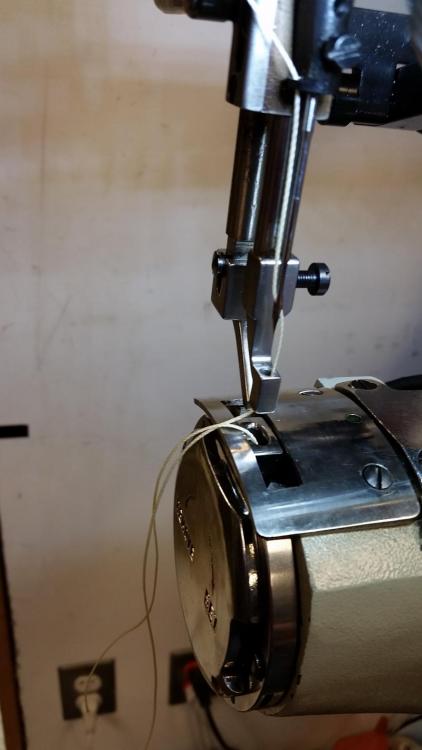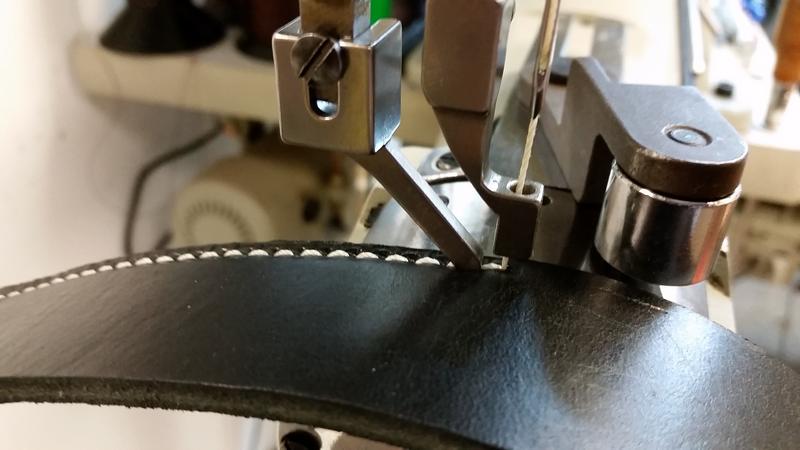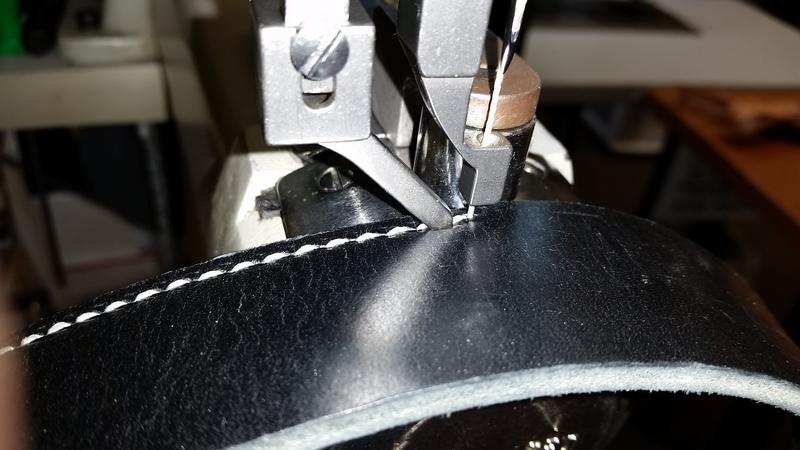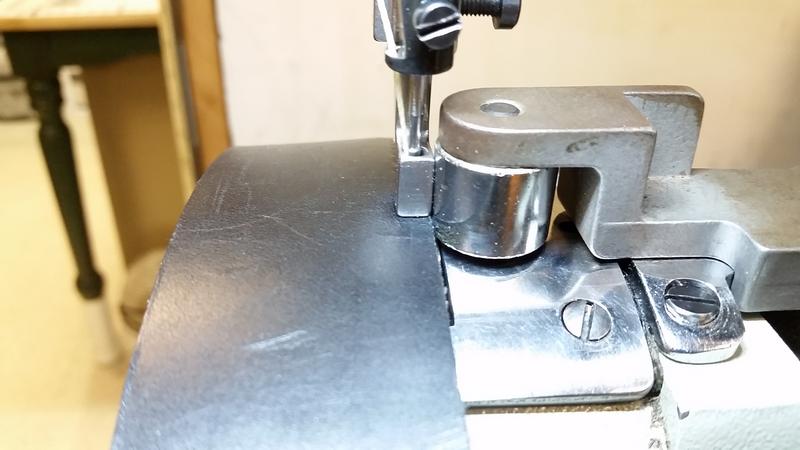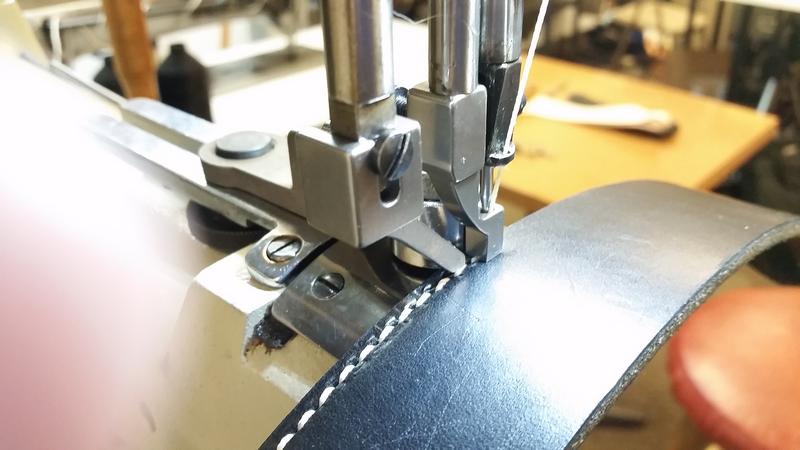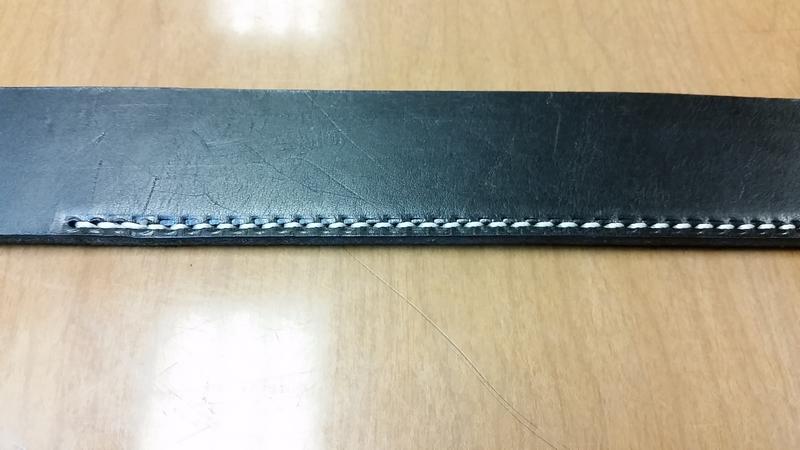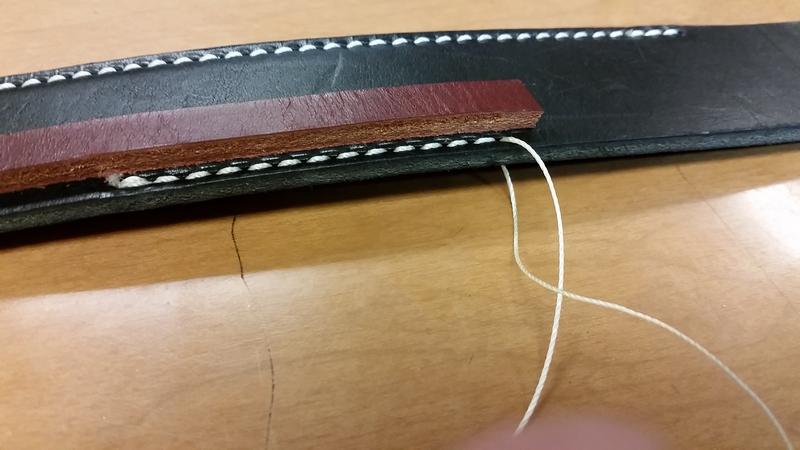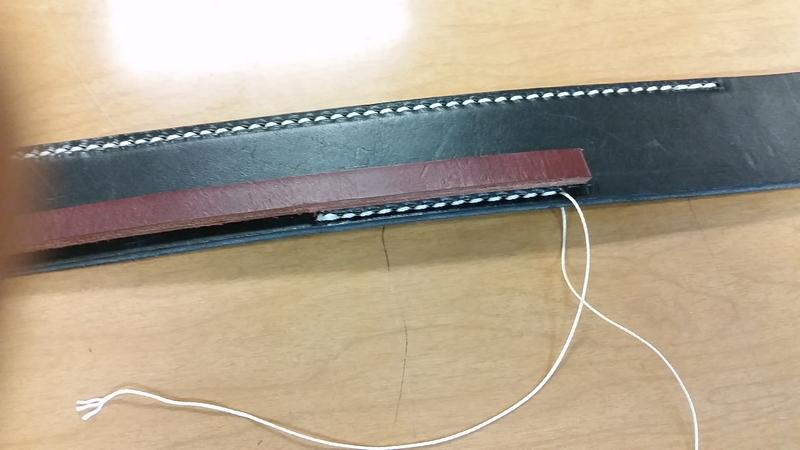-
Posts
7,736 -
Joined
-
Last visited
Content Type
Profiles
Forums
Events
Blogs
Gallery
Everything posted by Wizcrafts
-

Inline Cowboy presser feet on Cowboy CB4500
Wizcrafts replied to Wizcrafts's topic in Leather Sewing Machines
Of course. They should be made to swap with standard harness feet and no additional adjustments to the foot bars. I was referring to the original inline feet that are sold by the CowboySew company. -
I replaced the feed motion crank in my 29k71 two years ago and after filing the new "puck" for the best fit in the ring, it consistently gives me 5 spi
-

Inline Cowboy presser feet on Cowboy CB4500
Wizcrafts replied to Wizcrafts's topic in Leather Sewing Machines
I don't think they were made for a different machine. They fit perfectly into the presser and vibrating foot bars. I think that maybe the company had a raised holster plate on the machine when they designed these feet. They would be just the right length for those plates. Or, someone measured incorrectly. I don't speak Chinese so I can't ask them. I don't know if the new ones are the same length as mine, or have been corrected. -

Inline Cowboy presser feet on Cowboy CB4500
Wizcrafts replied to Wizcrafts's topic in Leather Sewing Machines
I'm your huckleberry -

Inline Cowboy presser feet on Cowboy CB4500
Wizcrafts replied to Wizcrafts's topic in Leather Sewing Machines
Uwe, I'd like to conspire with you on the design of the milled inline feet and a slightly raised throat plate to use with them.. -

Inline Cowboy presser feet on Cowboy CB4500
Wizcrafts replied to Wizcrafts's topic in Leather Sewing Machines
Lol, Thanks for the compliment. I've never been accused of being normal, nor have my friends and business associates. As for the video, I've done better in the past when I used a real camera. I miss my Leica M3, Canons, Rolliflexes and Graflex.. -

Inline Cowboy presser feet on Cowboy CB4500
Wizcrafts replied to Wizcrafts's topic in Leather Sewing Machines
As promised, here is a video I shot on my phone, showing the Cowboy inline foot set in action, on my Cowboy CB4500 sewing machine. I narrated the clip while my bearded business partner, Dan Ragan, did the sewing. Before we teamed up in 2012, he had never even touched a heavy leather stitcher. Now, after a couple lessons, he sews like a champ! Note that I am not a pro shooter. This was done ad-libbing on my Samsung S5, not on a real video camera (my Canon is broken ;-(). Hopefully, next time I shoot a video, I'll have a real camera and my 12" reflector lighting. -

Inline Cowboy presser feet on Cowboy CB4500
Wizcrafts replied to Wizcrafts's topic in Leather Sewing Machines
Note: It took me a good 20 minutes to switch over to the inline feet and get the presser and vibrating bar heights and thread tensions right. The more jobs I can do with them on, the happier I will be! -

Inline Cowboy presser feet on Cowboy CB4500
Wizcrafts replied to Wizcrafts's topic in Leather Sewing Machines
Don't kid yourself! That's what I thought when I bought these feet. Now, my last 3 repair and new build jobs have required these inline feet for the best results. The last job was resewing an added on decorative flap on the upper area of the top cover on a biker's saddle bag. Any other presser feet would have been less efficient. I only installed the inliners to post this article. Now, they are refusing to not be needed! -
If your Omega is a straight stitch garment machine, it probably uses system 1738/DBx1/16x257 needles. These are the most commonly sold needles in the garment trade. Another system used in some garment machines is the Pfaff system 134. They have a slightly wider upper shank, but about the same length from the top of the shank to the eye, plus or minus a few microns. Shorter needles translate into a shorter needle bar stroke, meaning less thickness can be sewn than a different machine that uses longer needles. Also, the pressure, top tension and check springs will probably be much lighter duty than those on a walking foot machine. If you are lucky, the machine will be able to sew with #80 jeans thread, using a #19 (or 20) needle. This thread is commercially available from suppliers to the garment trade, such as Wawak. They have everything you'll need, including needles,bobbins, thread, oil, lube, snips, bindings, Venture leather tape, et al.
-

Inline Cowboy presser feet on Cowboy CB4500
Wizcrafts replied to Wizcrafts's topic in Leather Sewing Machines
As I wrote in the Subject title: I'm using a Cowboy CB4500. But, any Cowboy, Cobra, Techsew 441 clone will take these feet, including the popular Cowboy CB3200. The feet are special order from Toledo Industrial Sewing Machines. He just ordered a bunch during the first week of July, 2017. The should be in this week, if not already. -

In-line presser foot for Pfaff 335, 1245, etc.
Wizcrafts replied to Uwe's topic in Leather Sewing Machines
See my topic about the using special inline feet on my CB4500. This setup will sew exactly along the edge, bypassing the studs, as needed per your photo. -
Most (but not all) upholstery class walking foot machines (if this is a walking foot machine) use system 135x16 leather point and 135x17 round point needles. Exceptions exist, especially in Pfaff machines. If it has two bars coming down, with feet on both, behind the needle bar, is a some form of walking foot machine. The #140/22 needle is waaaaaay too big for #69 thread. You should buy some #110/18 needles in leather point to sew leather with this thread. The #22 needle is meant to sew #138 thread, which is twice the diameter of your #69. Thread balls or knots underneath can be caused by incorrect top threading, or overly tight bobbin tension, or the thread binding in the bobbin shuttle mechanism as it cycles for a stitch. I'll guess incorrect top threading, with little or no top tension, for now.
-
Just about any modern walking foot machine can sew up to 3/8", or at least 5/16" of leather. The maybes include maybe it'll only sew 3/8" with #69 or 92 thread, or only with the presser foot pressure screwed all the way down. If that Mizti is being sold locally, ask for a demonstration. Bring some strips of leather and see how much can be sewn together before it breaks the needle or skips stitches.
-

Inline Cowboy presser feet on Cowboy CB4500
Wizcrafts replied to Wizcrafts's topic in Leather Sewing Machines
In case it's not obvious, the inline feet are used to sew very close to the right edge and slide past any hardware or raised leather that might be on the left of the needle. The width of the inside foot is the limiting factor. It is just over 1/8 inch wide, so you can sew a narrow strap, collar, lead, watchband or studded belt, without having the hardware deflect the foot and stitch line. The presser foot is inline and follows the vibrating foot. These feet are useful if you need to resew soles of shoes and boots. All you need is about 1/8 inch of leather protruding from the uppers to sew along the edge. Finally, because the inside vibrating foot is so tall, you can't sew as much thickness as with the harness feet. The maximum thickness is determined by the bottom of the needle bar's needle clamp in relation to the top of the inside foot where the needle hole is. It must not hit the top of the inside foot! -
Recently, some topics have come up exploring the available options for inline presser feet on walking foot machines. Some involve altering existing inside and/or outside feet to form an inline pair. But, for owners of a Juki 441 clone, there are commercially available inline feet made by Cowboy Sewing Machines. Since I own a set of these inline feet, I've decided to post some photos I took of them installed on my Cowboy CB4500. I should mention that these feet must be installed as a set and that you need to be aware that they are much shorter than a standard harness foot set. This is especially true for the back presser foot, which looks kind of like a pseudo-pod on an amoeba. But, I digress... Remove the existing inner and outer harness feet, avoiding the tip of the needle. If you want to play it safe, remove the needle first. Next, loosen the stop screw on the inside inline foot and slide it all the way uo to the milled collar on the vibrating foot bar (that's what Singer named the inside foot bar a looooong time ago). When it tops out, line it up with the needle (reinsert the needle) and lock it down tight on the bar. Now insert the rear foot onto the presser bar and set it as low as it will go without falling off, or contacting the back of the inside foot. Then lock it down tight. Because the feet are so short, in order to get the back foot to contact a single layer of 8-10 oz leather, you'll need to open the faceplate and lower the presser bar at least 1/4 to 5/16 of an inch. Don't worry about lowering it all the way to the feed dog. Just lower it enough so it firmly contacts the top of an 8-10 ounce test strip. There are two flat head screws on the steel block that the presser bar feeds through. There is a crankshaft in front of this block that will expose both screws if you rotate the handwheel to the correct position. Loosen the screws and pull down on the rear foot until is is about 1/8 inch above the feed dog, then turn it so it is as straight as possible and lock down the screws. Once the rear foot is in contact with the test strip of leather, you may need to loosen the large Allen bolt on the crankshaft coming out of the rear face of the machine and manually position the inside foot so it makes contact with the top of the leather just as or just after the tip of the needle makes contact. At that point you should lock down that big Allen bolt. This should give you fairly good alternating feed. Reinstall the faceplate and thread the machine. Run some test stitches to balance the tension, foot pressure and edge guide (if wanted) on the right side. I ran my test strip using 12 ounce bridle leather, #277 Cowboy thread and a #25 Schmetz S point needle. My edge guide was almost touching the right side of the inside foot. The photos will tell the rest. I made a video that I have to upload to YouTube later on. I will embed it in a follow-up reply once the video is available. If anybody with a Cowboy, Cobra, Techsew, or a Juki 441 or clone wants a set, contact Bob Kovar, at Toledo Industrial Sewing Machines: 866-362-7397. He told me on July 5, 2017 that he has some ordered and they should be in his shop by the second week in July. I don't know their cost at this time.
-

Help choosing the right sewing machine
Wizcrafts replied to craftsman827's topic in Leather Sewing Machines
Probably. That's where I got mine. -
Call Keystone Sewing, or Toledo Industrial Sewing Machines, or any industrial sewing machine dealer who has been in the trade for at least 20 years. They will find the right needles for your machine.
-
I like your shop Jess! Everything is laid out logically. As a fellow retail shop owner, I wish you the best of success!
- 19 replies
-
- leather workshop
- workshop
-
(and 2 more)
Tagged with:
-
Did you get the exact Pfaff needle system that this machine requires? If not, a too long needle will be bent by the hook, as you noticed. A needle too short won't pick up the bobbin thread. I found that there are 6 different sub-classes of the Pfaff, with different needle systems. Here is a reply I found to someone else who bought a 138 without a needle. SCHMETZneedles says: July 28, 2016 at 10:06 am Need to know the machine class. The SCHMETZ Needle catalog shows six entries for the PFAFF 138 depending upon machine class: PFAFF 138 – ALL CLASSES EXCEPT —— Uses Needle System 265KK, 438KK, DPx438KK 138 – 6-21-915-01 —————— Uses Needle System 130B, DBx130B 138 – FROM 1948 – 1952 ——— Uses Needle System 134R, 135×5, SY1955, DPx5 138 – 275-01 ————————- Uses Needle System 134EK, DP-P5 138 – 277-01 ————————- Uses Needle System 134R, 135×5, SY1955, DPx5 138 – 915-01 ————————- Uses Needle System 130B, DBx130B
-

Help choosing the right sewing machine
Wizcrafts replied to craftsman827's topic in Leather Sewing Machines
The 441 clones all accept a special Cowboy brand presser foot set that is inline. The footprint is about 1/8" or so, depending on how precisely the back foot lines up with the front foot. I use this set to occasionally re-sew boot soles, or to sew next to hardware, like your example. The way the feet are built reduces the thickness that can be sewn somewhat. But, since most of these machines can sew at least 3/4 inch, it doesn't matter that much. Here is a photo of the Cowboy inline foot set. -
Your serial number says that you have a Model 27, which is NOT an industrial sewing machine. The only way to find parts for it is to buy another Model 27 for parts. The best place to find these ancient treadle heads is in antiques malls, Salvation Army stores and Craigslist. I've reconditioned and sold three of them and have one more sitting on a foot stool inside our shop. We use it to sew satin linings that the walking foot machines would eat.
-
I use Foxit PDF reader to view PDF files. But, my browsers all contain a built in reader. So, the only time I open Foxit is when i have downloaded and saved a PDF. I am speaking about personal computers here, not Androids or iDevices.
-
PDF is the preferred file format for manuals. Almost every modern browser has a built in PDF viewer. In contrast, very few non-business computers have Microsoft Word any more. It would require one to download either the free Microsoft Word Viewer, or an alternate office program. You might want to think about uploading a PDF version instead of a proprietary Microsoft format.
-
Tandy Leather has pattern packs for leather vests. I've had mine for several decades. What it didn't show was how to fit and install a satin lining, which is necessary to prevent the flesh side from getting on your shirts. Any seamstress can show you how to add a lining, including one with inside pockets.



